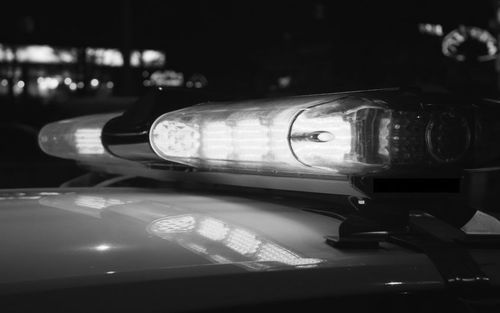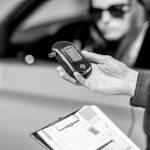What Is Field Sobriety Testing?
Everyone knows the hit classic, “I Walk the Line” by Johnny Cash. But have you ever been pulled over in North Dakota by a law enforcement officer and asked to walk in a straight line? Has an officer ever requested to look at your eyes and have you follow his pen or finger? These are all types of field sobriety tests (FST’s) that officers are permitted to conduct if they believe you are driving under the influence.
Do I Have To Conduct An Officer’s Field Sobriety Tests?
North Dakota law does not require you to take an officer’s FST’s. Submitting to an officer’s request to conduct FST’s is voluntary. If an officer requests FST’s, you may politely refuse the tests. Generally, there are no penalties for refusing FST’s. The one exception to this rule is the Preliminary Breath Test (explained more below). If you refuse to conduct FST’s none can be given and the officer will have to determine if he has probable cause to arrest you for DUI without conducting the FST’s. However, if you do decide to submit to the FST’s, the officer can use the results of the tests against you to determine whether he has probable cause to arrest you for DUI. So what FST’s would an officer request? What clues do they look for? Will I have to say the alphabet backward?
Standardized Field Sobriety Tests
The National Highway Traffic Safety Administration (NHTSA) recognizes three tests as standardized field sobriety tests. These three tests are considered to be standardized because they are based on a series of controlled laboratory studies conducted by NHTSA. However, some experts have determined these tests are unreliable and suggest the way NHTSA conducted the research to make these determinations lacked the necessary standards required for credible scientific studies. The three tests are the Horizontal Gaze Nystagmus Test, the Walk and Turn Test and the One Leg Stand Test.
The first test, which is normally the most common test, is the Horizontal Gaze Nystagmus (HGN) test. Prior to the officer conducting the test, they must check your eyes for equal pupil size, resting nystagmus, and equal tracking. The officer will also generally ask about the individual’s eyes and general health conditions prior to administering the test. When the officer conducts the HGN test, they will move their pen, finger, or another type of stimulus side to side. While they do this, they will be looking for three different clues in each eye resulting in a total of six possible clues. The three clues include the lack of smooth pursuit, distinct and sustained nystagmus at maximum deviation, and the onset of nystagmus prior to 45 degrees. If an officer observes four or more clues, it indicates to the officer that you may have a BAC over the legal limit. The officer will also move the stimulus up and down to determine if you have vertical nystagmus. Vertical Gaze Nystagmus is associated with high doses of alcohol and may indicate certain drug use.
The second test, which is also commonly administered and one of the most well known, is the Walk and Turn (WAT) test. The WAT is the test that most people refer to as “walking the line.” The WAT test has eight distinct clues that the officer must look for when administering the test. The first clue the officer looks for is if the individual cannot keep their balance while listening to instructions. The officer will tell the individual to stand in a heel-to-toe position throughout the instructions. If an individual fails to do so or loses their balance and steps out of position, the officer will make note of the clue. There are seven other clues the officer looks for while administering the test. Those clues are: if the individual starts the test too soon, stops while walking, does not touch heel-to-toe, steps off the line, uses their arms to balance, does an improper turn, and does an incorrect number of steps. If an officer observes two or more clues, it indicates to the officer that you may have a BAC over the legal limit.
The final standardized FST is the One Leg Stand (OLS) test. During the OLS test, an officer will ask the individual to plant one leg and lift their other leg approximately six (6) inches off the ground for thirty (30) seconds. There are four clues the officer will look for while observing the OLS test. The four clues include swaying your arms while balancing, using your arms to balance, hopping, and putting your foot down. If an officer observes two or more clues, it indicates to the officer that you may have a BAC over the legal limit.
Non-Standardized Field Sobriety Tests
A common question that is often asked is “Do I have to say the alphabet backward?” The answer to that question is no. An officer will likely not ask you to recite the alphabet backward. However, an officer may ask you to recite the alphabet or part of the alphabet. These would be considered non-standardized FST’s. There are four different non-standardized FST’s that officers commonly use. The first test, as previously mentioned, would be to say the alphabet without singing. A second test would be to say part of the alphabet. For example, an officer may ask you to say the alphabet from the letter “C” to the letter “Q” without singing. A third test an officer may use is the reverse count test. Similar to the partial alphabet, the officer would give you a range of numbers and ask you to count backward. For example, the officer may have you start with the number 56 and end with the number 39. A fourth test an officer may request is the finger dexterity test. For the finger dexterity test, an officer will instruct an individual to touch the tip of their finger to the tip of their thumb and count out loud. When the individual touches the tip of their index finger they would say one, then two for the middle finger, three for the ring finger, and four for the pinky finger. They would then reverse the order and touch the tip of their thumb to their pinky finger and say four, touch their ring finger and say three, touch their middle finger and say two, and then touch their index finger and say one. The officer would normally have the individual repeat this several times. Although these are the four most common tests, an officer may administer other non-standardized FST’s.
Preliminary Breath Test
The final test an officer may request prior to an arrest is a Preliminary Breath Test (PBT). This is the only test that would not be considered “voluntary.” Although you may refuse the PBT if you choose, there are administrative penalties associated with refusing the test. Pursuant to North Dakota Statute § 39-20-14(3), an officer shall inform an individual that “North Dakota law requires the individual to take the screening test to determine whether the individual is under the influence of alcohol and that refusal of the individual to submit to a screening test may result in a revocation for at least one hundred eighty (180) days and up to three (3) years of that individual’s driving privileges.” Thus, if an individual chooses to refuse the PBT, they will face license revocation. However, the director must not revoke an individual’s driving privileges for refusing to submit to a screening test requested if the individual provides a sufficient breath, blood, or urine sample for a chemical test. See N.D.C.C. § 39-20-14(4). Prior to submitting to a chemical test, it is in your best interest to contact an experienced criminal defense attorney. After contacting an attorney, if you decide to submit to a chemical breath test, you would “cure” the previous PBT refusal if the officer still arrests you for DUI following the refusal of the FSTs and PBT.
In Conclusion
DUI charges are complex, and seeking legal representation may be in your best interest. If you have a criminal issue in North Dakota, please do not hesitate to call our Criminal Defense Team at SW&L Attorneys in Fargo at 701-297-2890.
This article is only meant to provide general information and does not constitute legal advice.










